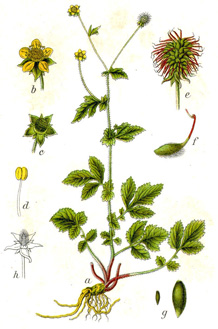Geum:
Blessed Garden Gem
By Audrey Stallsmith

Where the root is in the house, Satan can do nothing and flies from it, wherefore it is blessed before all other herbs, and if a man carries the root about him no venomous beast can harm him.
The Ortus Sanitatis, 1491
I was cleaning out a weedy section of my garden the other day when I came across some geum plants that I grew from seed last year and completely forgot. As A. A. Milne put it, "One of the advantages of being disorderly is that one is constantly making exciting discoveries!"
The plants didn't seem to mind the neglect and had quietly budded anyhow. Growing one to two feet tall with flowers that look like 2-inch double little roses, geum bears some resemblance to the strawberry as well--since all belong to the same family. My current variety is 'Blazing Sunset,' but I have also grown 'Mrs. Bradshaw' in the past. Though both of those types are red, garden geums are also available in yellow, orange, and pink.
Their foliage is so attractive that it was once carved on the pillars of cathedrals, though there was another reason for that as well. This Herb Bennett or "blessed herb" reportedly repels the devil and all other wicked or harmful influences--including poisons! The 3-leaf clusters on the species type, Geum urbanum, are supposed to represent the Trinity and their five yellow petals the wounds of Christ.
In the past, this wildflower was more commonly known as avens, though there is some debate as to the origin of that name. Some think it derived from avencia, a form of clover, and others contend that it is a corruption of aveo ("to rejoice"). Urbanum means "belonging to towns," while geum itself comes from the Greek geno ("to yield an agreeable fragrance")-- in reference to the clove scent of its roots.
Those roots are the part of the plant most used in medicine and should, according to tradition, be harvested on March 25. The herb is closely associated with St. Benedict, whose original feast day was on the March 21, so the recommended date of digging may have slipped a little over the years! As Benedict is supposed to have exorcised poison from a cup of wine that he blessed, plants considered antidotes are often identified with him.
Being somewhat astringent, geum root is used to stop bleeding and diarrheas and has been recommended for the treatment of colds, respiratory infections, sore throats, headaches, stomach problems, and bad breath. It can reportedly cure fevers so well that it was sometimes used in place of quinine to treat malaria. The plant's "clove root" has also flavored ale, scented linens, and faded freckles. It was even boiled in wine as a cure for the plague.
It's too bad that avens seems to have been largely forgotten in more recent times, much as I forgot it in my own garden, because it's one of those plants that can make you happy just to look at it. I've always intended to get water avens (Geum rivale) for my garden as well. With interestingly shaped drooping purple flowers, it grows wild in wet places here in the U. S., and was sometimes known as Indian Chocolate. I suspect that name refers to the color rather than the flavor, but any plant with "chocolate" in its name has to be blessed!
Geum urbanum image is from Deutschlands Flora in Abbildungen, courtesy of Wikimedia Commons.








